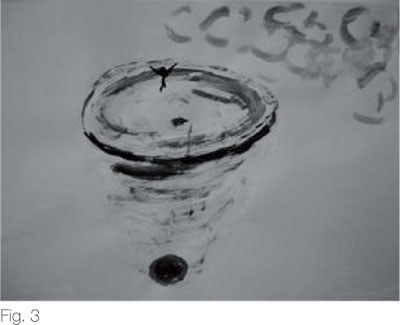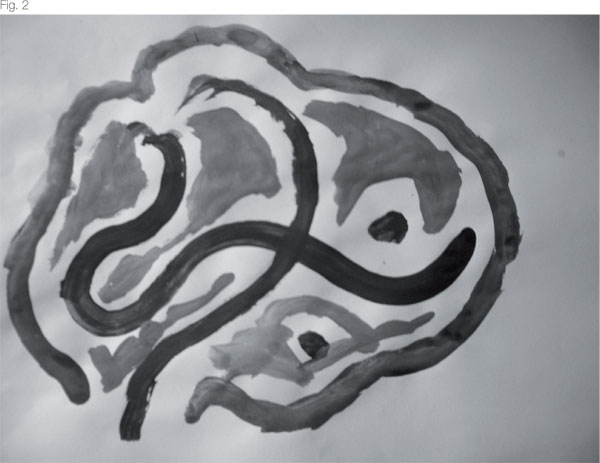Web-site restrictions
ACAT will be moving to a new web site on Thursday, 10th April.
In preparation, from Friday, 4th April this old web site will not let members renew their membership, and any other changes members make, e.g. their personal details, will get ‘lost in the move’.
Urgent membership renewals should instead be done by contacting Alison Marfell.
Plugging in and Letting Go: the Use of Art in CAT
Hughes, R., 2008. Plugging in and Letting Go: the Use of Art in CAT. Reformulation, Summer, pp.9-10.
workshop presented at the ACAT Conference 2008
The title for this workshop came from the comment of a CAT trainee on the second day of the North London CAT Training course set up by Shirley Akgun at the Halliwick Psychological Therapy Service in St Ann’s Hospital, Tottenham. It was the last part of the afternoon of what had been an intensive two days of induction and lectures. Following vital reams of housekeeping, as it were, Jackie Baker introduced the trainees to Reciprocal Roles. Shirley read out a letter of welcome to CAT from Tony Ryle, and our minds were intensely focused on the new language and its meanings. It was my role to bring the group together, to think about the journey opening up ahead for the next two years and to move focus onto the experience of training as the trainees anticipated it.
Everyone was invited to use art materials to make two images of how they felt in relation to CAT now and themselves as CAT therapists upon completion of the training. The materials didn’t daunt and a period of quiet but lively activity was followed by thought and sensitive discussion. It was then that one of the trainees used the term ‘plugging in and letting go’, with a sense of satisfaction at the different space that this time had provided. The ‘plugging in’ seemed to speak of experiencing another way of being and relating, and of this feeling personal. Something in the ‘letting go’ spoke perhaps of being together but separate, and this was in a sense a reciprocal role change. In Winnicotian attachment terms we might see this as a move away from the nurturing (but demanding) parent inevitable at the start of a transitional journey in to a new professional role. The images supported a dialogue about themselves. Seeing similarities and differences began the process of self-recognition and peer validation. This took people to an adult-to-adult relationship through the use of the art materials. This object use became a container in Bion’s sense of the therapeutic container. This largely non-directive activity created a transitional space.
In my CAT practice I have invited patients to use art for just this reason - bringing into play a different modality for transition, both for processing target problems and subtly promoting a different collaboration between the two of us. For further reading in this domain people may like to read Inscape: International Journal of Art Therapy, and in particular ‘An enquiry into an Integration of Art Therapy and CAT’ June 2007. W D Winnicott’s book Playing and Reality talks about the development of independence and is very relevant to our work in CAT whereby we integrate psychodynamic concepts and strategies with socioeducational techniques.
One patient felt overwhelmed by the pressure of his work as an architect. We explored how a dissatisfied and dismissive internalised adult role made him feel depressed and out of control. Yet in the room he was commanding and often buoyant. At times I felt that I was identified with the subjugated aspect of him, which was incongruent with the perception he had of himself. Then one day he brought a cartoon to his session, and as you can see (fig 1) he was internally in the bottom of the reciprocal role whilst perceiving others and me in the empowered role. This image opened up a moment of shared laughter, which in turn allowed for a discussion of his concealed emotional and practical needs when he was stressed. This discussion resulted in an increased awareness of how he moved defensively into the top role. He checked this perception out with a family member and began to work at adjusting his response to corporate stressors and to modifying the role reversal he used to defend.
Another patient had experienced violent abuse and a prolonged and more insidious exploitation. This combination left him alert to abuse but often struggling to feel masterful. Trust was double edged and so our alliance was both hopeful and mistrusting, with a clear communication that healing was unlikely, since a guardian figure from childhood had damaged the client’s sense of goodness. The ‘other’ was often seen as crushing. One day he painted an image of what he felt was his brain (fig 2). This held his gaze for sometime, and it felt as if we had left the painful dance between trust and hopelessness as he contemplated this new creation. It seemed that by painting this image himself and seeing what he felt was a bitter cross within it, he was beginning to own that the problems of the past were not necessarily out there but within himself. In this vignette it was the use of art that helped him clarify what we in CAT call the ‘observing eye’ or the ‘observing I’. The use of art, in this case, took the transference away from the therapist and turned it into something more fully owned by the client, communicating and holding his personal honesty.
A professional lady from a striving background had little personal endearment to her depressed phases of a diagnosed bi-polar problem. She dreaded her depression and we grappled with the meanings of a problem embedded in biochemistry and reciprocal role difficulties. However by her painting an image to depict her depression and the movement into and out of it (fig 3), we were able to suspend striving for a judgement about where it lived, so to speak, and began to think together about what she might need to help heal the pain of her unique life. The sessions had been dominated by her poignant but intellectualising struggle, as she experienced ambivalence and hurt pride, having accepted a professional prompt to attend therapy. The image she painted to some extent provided us with an exit from this way of relating. The core pain was now held in the image and so we could talk to it with out it being so ardently hidden. In this way the artwork helped the working and therapeutic alliance.
In my experiential workshop at the ACAT conference, participants used art materials to explore a reciprocal role procedure (RRP) from their clinical practice. I’d suggested using an RRP that felt current and warm. To avoid the trap of deadening the creative moment by intellectualisation, handouts were distributed for later reading. One was a paper on CAT and art therapy, and the other was a sheet of points thinking about art therapeutically. Time was short and so participants set to work on their images. Afterwards, people spoke about their art work and how it had felt to be engaged in what was to some an alien or child like process. Some swam into the reverie happily and new insights emerged. Others felt put off by the sight of paint and slid out; still others were disappointed that there wasn’t time for them to speak about their pictures. All the work was seen and shared at different levels. I hope this was a space for them to experience how art can inform the therapeutic process and a break, during a ‘heady’ conference, in which they could ‘plug in and let go.’





Full Reference
Hughes, R., 2008. Plugging in and Letting Go: the Use of Art in CAT. Reformulation, Summer, pp.9-10.Search the Bibliography
Type in your search terms. If you want to search for results that match ALL of your keywords you can list them with commas between them; e.g., "borderline,adolescent", which will bring back results that have BOTH keywords mentioned in the title or author data.
Related Articles
Integrating Art Psychotherapy and Cognitive Analytic Therapy (CAT)
Rose Hughes, 2013. Integrating Art Psychotherapy and Cognitive Analytic Therapy (CAT). Reformulation, Summer, p.44,45,46,47,48,49.
Comment on James Turner’s article on Verbal and Pictorial Metaphor in CAT
Hughes, R., 2011. Comment on James Turner’s article on Verbal and Pictorial Metaphor in CAT. Reformulation, Winter, pp.24-25.
How to Enjoy Writing a Prose Reformulation
Wilde McCormick, E., 2008. How to Enjoy Writing a Prose Reformulation. Reformulation, Summer, pp.16-17.
Impressions of Finland
Curran, A., 2000. Impressions of Finland. Reformulation, ACAT News Summer, p.x.
Do We Allow CAT To Have A Heart - And If We Do, Does This Make It Soft And Wet?
McCormick, E., 1995. Do We Allow CAT To Have A Heart - And If We Do, Does This Make It Soft And Wet?. Reformulation, ACAT News Summer, p.x.
Other Articles in the Same Issue
CAT Used Therapeutically and Contextually
Murphy, N., 2008. CAT Used Therapeutically and Contextually. Reformulation, Summer, pp.26-30.
Catch up with CAT
Potter, S., Curran, A., 2008. Catch up with CAT. Reformulation, Summer, p.54.
Clinical Implications for the Pregnant CAT Therapist
Knight, A., 2008. Clinical Implications for the Pregnant CAT Therapist. Reformulation, Summer, pp.38-41.
Consent to Publish in Reformulation
Jenaway, A., Lloyd, J., 2008. Consent to Publish in Reformulation. Reformulation, Summer, p.7.
Cuckoo Lane
Selix, M., 2008. Cuckoo Lane. Reformulation, Summer, p.6.
How to Enjoy Writing a Prose Reformulation
Wilde McCormick, E., 2008. How to Enjoy Writing a Prose Reformulation. Reformulation, Summer, pp.16-17.
Integration of Cognitive Analytic Therapy Understandings
Ruppert, M., Birchnall, Z., Bruton, C., Christianson, S., 2008. Integration of Cognitive Analytic Therapy Understandings. Reformulation, Summer, pp.20-22.
Is CAT an Island or Solar System?
Bancroft, A., Collins, S., Crowley, V., Harding, C., Kim, Y., Lloyd, J., Murphy, N., 2008. Is CAT an Island or Solar System?. Reformulation, Summer, pp.23-25.
Letter from the Chair of ACAT
Westacott, M., 2008. Letter from the Chair of ACAT. Reformulation, Summer, pp.3-4.
Letter from the Editors
Elia, I., Jenaway, A., 2008. Letter from the Editors. Reformulation, Summer, p.3.
Metaprocedures in Normal Development and in Therapy
Hayward, M., McCurrie, C., 2008. Metaprocedures in Normal Development and in Therapy. Reformulation, Summer, pp.42-45.
Plugging in and Letting Go: the Use of Art in CAT
Hughes, R., 2008. Plugging in and Letting Go: the Use of Art in CAT. Reformulation, Summer, pp.9-10.
Service Innovation
Jenaway, A., Mortlock, D., 2008. Service Innovation. Reformulation, Summer, pp.31-32.
Silence in Practice
Harvey, L., 2008. Silence in Practice. Reformulation, Summer, pp.11-13.
The ‘Human Givens’ Fast Trauma and Phobia Cure
Jenaway, A., 2008. The ‘Human Givens’ Fast Trauma and Phobia Cure. Reformulation, Summer, pp.14-15.
The Body in Dialogue
Burns-Lundgren, E., Walker, M., 2008. The Body in Dialogue. Reformulation, Summer, pp.18-19.
The Development of the Sequential Diagrammatic Reformulation
Parkinson, R., 2008. The Development of the Sequential Diagrammatic Reformulation. Reformulation, Summer, pp.33-37.
The States Description Procedure
Hubbuck, J., 2008. The States Description Procedure. Reformulation, Summer, pp.46-53.
Help
This site has recently been updated to be Mobile Friendly. We are working through the pages to check everything is working properly. If you spot a problem please email support@acat.me.uk and we'll look into it. Thank you.
